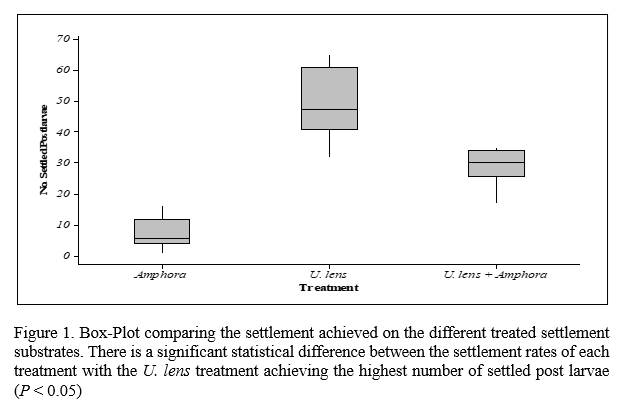EFFICACY OF NOVEL SETTLEMENT SUBSTRATES FOR STANDARDISING SETTLEMENT FOR COMMERCIAL PRODUCTION OF ABALONE AND SEA URCHINS
Introduction
Inconsistent settlement rates for commercially important species remain a bottleneck at the beginning of the production value chain. The commercially important species such as sea urchin Paracentrotus lividus, and abalone Hailotitos discus hannai & H. midae are increasing in commercial interest for aquaculture in Europe and South Africa.
However suitable larval settlement substrates (e.g. Ulvella lens) remain untested and in many commercial settings. Inconsistent low settlement rates are currently achieved at the nursery stage by commercial hatcheries and efforts to establish other commercial hatcheries around Europe, have been hampered by inconsistencies in production, which remain a key bottleneck (Hannon et. al., 2013, Lawrence and Lawrence, 2014).
Development of settlement cues and production methods by the Hannon et. al., (2014) have been transferred from Ireland to Spain (2015) and South Africa (2017) to support hatchery production of sea urchins and abalone under commercial conditions. This presentation is evaluating the efficacy and implementation of the use of novel settlement cues and how they can be used to standardise settlement with a guaranteed average settlement range of 50-70% inside 24-hours from transfer to settlement tanks or systems.
Under commercial conditions postlarval survival increases significantly once an effective settlement cue is utilised with an overall increase of 30-40% hatchery output for the same time period.
Materials & Methods
Overcoming the production barriers for the culture of Ulvella lens required the streamlining of the production method to aid the tech transferability to commercial production. This required the removal of the trial and error approach. All cultures were establish under commercial conditions at commercial facilities in Ireland, Spain and South Africa.
Cultures of U. lens were isolated and scaled up in culture to increase available adult sporophyte biomass for mass sporulation which can be repeated every 14-days once the sporulation cycle is initiated. This has halved the current time from the original method developed in the 1980s’. Post larval settlement and survival was assessed along with their feeding transitions and weaning
Results
Significant differences were observed when the cues were assessed at commercial scale when compared to the benthic diatoms (e.g. Amphora Spp.). Using monospecific diatoms have been shown to increase settlement rates than relaying on natural assemblages of wild benthic diatoms available to hatcheries. When U. lens is used in commercial production we have seen an average settlement rate of 50-70% inside the first 24-hours after the competent larvae are introduced to the settlement cue (Figure 1).
Discussion
U. lens can be used as a settlement cue for sea urchins, abalone and sea cucumbers and is ready for transfer into commercial production of low trophic aquaculture species in the hatchery .
knowledge transfer resulted in a fully scaled U. lens hatchery directly improved spat production by 30% to 40% for abalone hatcheries and resulted in a on average settlement of 50-70% for sea urchins under commercial conditions.
Hatcheries are very complex and the U. lens used in the settlement phase gave the species produced a head start in life; and not only did settlement production improve, but so did weaning survival as the macroalgae phase of the mollusc was already achieved in settlement , and sea urchins are able to graze as postlarvae with no feeding transition period or loss in growth rates.
References
Hannon, C., Officer, R.A., Dorven, J., 2013. Review of the technical challenges facing aquaculture of the European abalone Haliotis tuberculata in Ireland.
Hannon, C., Officer, R.A., Le Dorven, J., Chamberlain, J., 2014. Culture methods of live algal feeds for European aquaculture: optimising culture conditions for Ulvella lens. Aquac. Int. doi:10.1007/s10499-014-9784-4
Lawrence, J.M., Lawrence, J.M., 2014. Sea urchins biology and ecology. Elsevier.
